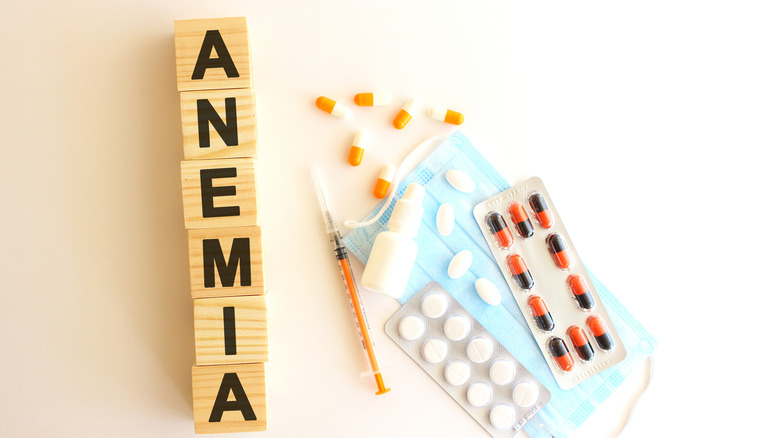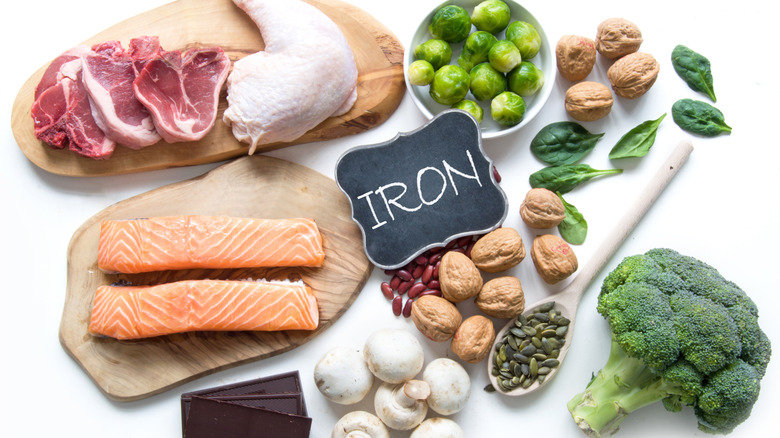The Best Tips For Preventing Anemia
If you've ever experienced the obnoxiously persistent icy-cold-feet-feeling that often haunts those with anemia, you know how uncomfortable it can be. You probably have a good idea as to why you would want to do your very best to prevent anemia altogether, whenever possible.
According to Mayo Clinic, anemia is a condition defined by a deficiency in healthy red blood cells — the little messenger cells that use hemoglobin and iron to carry oxygen to our organs. When our organs aren't getting adequate oxygen, it can result in a multitude of uncomfortable symptoms that go far beyond the aforementioned feet-sicles. Anemia can cause fatigue, weakness, shortness of breath, dizziness, cold and pale skin that easily bruises, headaches, chest pains, and irregular heartbeats.
There are a few different types of anemia, ranging in severity, each with their own causes and treatments. Let's take a closer look at why anemia happens and how you can best prevent it.
Types of anemia
Anemia is the most common blood disorder, affecting nearly 30% of the world's population (per Cleveland Clinic). Women, infants, children between the ages of 1 and 2, adults over the age of 65, and people on blood thinners are disproportionately affected by the condition. That's because the most common cause of anemia is iron deficiency, which these groups are prone to.
A study published in Nutrients reports that iron deficiency is to blame for 50% of anemia diagnoses. The hemoglobin that red blood cells use to carry oxygen throughout the body is produced in the bone marrow with the help of iron (per Mayo Clinic). When we aren't consuming enough iron, our bodies can't make enough hemoglobin, and anemia ensues. And iron isn't the only thing bone marrow needs to make hemoglobin. If we are not consuming enough B12, we might develop what is referred to as vitamin-deficient anemia.
While anemia is often the result of a deficiency in our diets, some types of anemia happen as a result of other illnesses that damage or slow down the production of red blood cells. Anemia of inflammation occurs when inflammatory diseases interfere with the body's ability to produce red blood cells.
More dangerous and life-threatening anemias include aplastic anemia which often results from certain infections, exposure to toxins, or autoimmune diseases like lupus and sickle cell anemia. Sickle cell anemia is an inherited form of anemia that causes a persistent scarcity of healthy red blood cells.
Tips for preventing anemia
While some kinds of anemia are a little more out of our control, anemia caused by a deficiency in iron, B12, or folate can often be prevented or easily treated with some simple life changes. To treat or prevent anemia as a result of iron deficiency, the National Office on Women's Health recommends a diet high in iron-rich foods. These include beef, liver, eggs, beans, tofu, dark leafy greens, chickpeas, and lentils. You might also try loading up on oranges, broccoli, and tomatoes, since vitamin C helps the body to better absorb iron.
Iron supplements are available if your doctor deems them necessary. However, taking iron supplements can cause side effects, like constipation and upset stomach. It is possible to get too much iron, which could cause problems for the heart and pancreas, so try to keep your intake around 45 milligrams a day. If B12 or folate is what you're lacking, your doctor might offer a B12 shot or folate supplements (per Johns Hopkins Medicine). But you might be able to avoid that by adding more B12 and folic acid into your diet with foods like fish, shellfish, beef, poultry, eggs, and milk.
If you believe you might have anemia as a result of an iron or vitamin deficiency, talk to your doctor. A simple blood test can reveal whether or not you're anemic. Further testing can decipher whether your body is low on iron, B12, or folate — and why.



